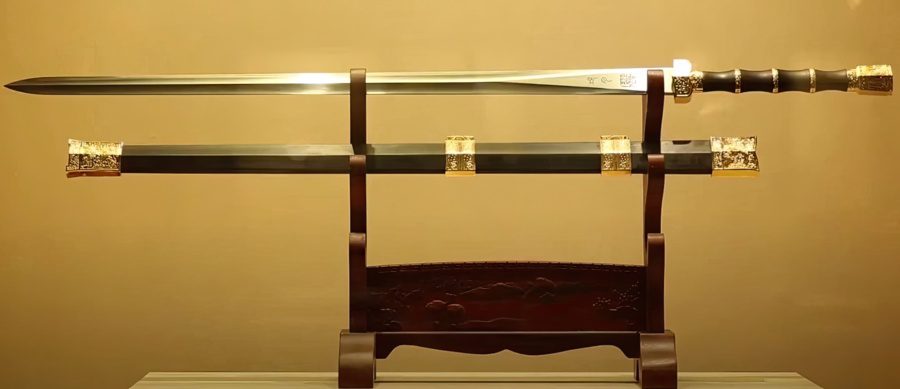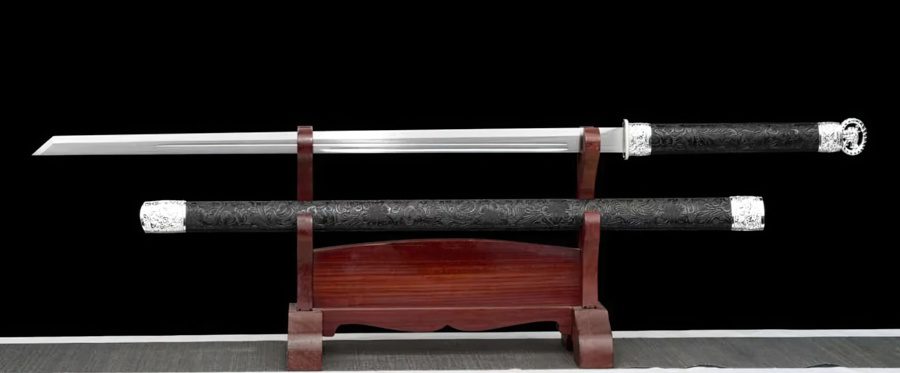The Sharpest Sword in Ancient China: Finding the Deadliest Blade

What’s in this article?
Chinese swords can be seen as works of art thanks to their beauty, elegance, and elite craftsmanship. However, despite playing a very big ceremonial, cultural and prestigious role, swords were created as a means of destruction based on their durability, strength, and cutting power.
Sharpness often renders just how powerful a sword is; for some, it is the biggest and most important factor a blade needs to have. In this article, we will present you with a brief list of the sharpest swords created and used in Ancient China, a period that lasted close to 2000 years.
Sharp After 2000 Years – Goujian Sword

We will start with the oldest and best-preserved ancient sword that is still sharp enough to be deadly if used today – the Goujian Sword. The Goujian blade is an example of how sharp double-edged bronze Jian blades could be if designed and constructed properly.
The blade is double-edged, meaning sharpened on each side, and tapers to a sharp tip giving the sword powerful slashing and thrusting capabilities. The Chinese technological metallurgy was not advanced with these blades at the time. Still, they could be used, especially during the turbulent spring and autumn warfare in China.
The Goujian blade is just a type of bronze Jian made and manufactured by the King of Yue. Still, blades similar to this can be seen on many of the Soldiers of the Terracotta Army Tomb, saying that ancient Chinese blades could be very sharp and useful in warfare but would not come close to later iron or steel swords.
The First Deadly Sharp Blade – Longquan Sword

The Longquan sword, designed by the father of ancient Chinese iron swords, Ou Yezi, is considered the first deadly and sharp ancient Chinese blade that directly influenced the battlefield. Bronze Jian swords existed prior to, and in some cases, traced back to the Shang Dynasty (16 – 11th century BC) but never came close to the level of the Longquan sword.
Making the Longquan sharp blade took quite a bit of work, and only finding the finest iron ores from the Longquan Mountains, with the purest and steadiest flow of water, could bring this ancient blade to be as sharp as it was.
It is said that it took 28 steps of Chinese swordsmithing ancient skills to create this sharp blade with little to no competition in the regions. Its sharpness alone made the bronze sword a decorative tool, and it was completely replaced over time.
Sharpest of The Era – Han Dao

The Han Dao single-edged blade, constructed and widely spread throughout the Han Dynasty, is the sharpest blade of its time. The Han Dao sword was so popular and effective that the sharpness of the single edge would completely influence the history and evolution of Chinese swords, replacing the double-edged Jian over time.
Although the double-edged blade could be very sharp and useful in both slashing and thrusting, the metallurgical advancements made the single-edged blade much sharper than the other, thanks to the larger length of the steel that the sharpness could extend to.

The sharp Dao blade became the main weapon of the soldiers in China and remained that way throughout the next two millennia.
Constant warfare and battles brought the need for stronger, more durable, and sharper blades to appear. The spine and core of the blade were made with more flexible steel, while the edges were stronger and could take a lot more sharpening. This resulted in a very sharp blade that could easily pierce through flesh and be useful against lightly armored units of the time.
The Pinnacle of Sharpness – Tang Heng Dao
The sharpest blade in ancient China was the Tang Dao blade, made during the Golden Age of China. Although it isn’t always mentioned in ancient Chinese history, it should be because the level of sharpness was exceptional and highly influenced all of the blades in East Asia.
The steady progress of metallurgical advances peaked in the Tang Dynasty. The blade designs and forms of the Han era would evolve into real weapons of destruction due to the differential heat treatment.
With differential heat, certain parts of the blade could be made with varying flexibility, sturdiness, power, and sharpness. The carbon sandwich plates were straight and sharpened across the entire length of the steel, with the addition of clay on the sharp edge to make them even sharper. This method is popular today on Japanese swords like the Katana.
This sharpness and shape of the Tang swords would be the envy of all, giving rise to the single-edged blade to become Asia’s main sword, which would slightly curve with time.
Were Ancient Chinese Swords Sharper Than European Swords?

Ancient Chinese and European swords differ quite a bit, but they are both superb weapons in the style of battles they are used in. The short answer is that ancient Chinese swords were sharper than European ones, but this is due to combat and battlefield preferences and the earlier rise of their swordsmithing skills.
In ancient Europe, the short Gladius was known for its sharpness, but other than the blade tip used for thrusting, the sword didn’t rely on its level of sharpening as did the Jian or early Dao. If Europe had followed the sleek, thin sharp design of the Chinese blades, they would easily break during battle.
In Medieval Europe, especially during the peak of ancient Chinese swords during the Tang Dynasty, sturdy and broad swords were the most common simply because that was what was needed. This is the case with the Carolingian or Viking sword, which came from the longer Roman Spatha and could be effective against mail armor and shields without easily cracking or breaking during usage.




